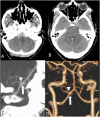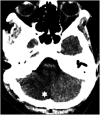Delayed Diagnosis of Postpartum Subarachnoid Hemorrhage Caused by Vertebral Artery Aneurysm: A Case Initially Misdiagnosed as Post-Dural Puncture Headache
- PMID: 41024942
- PMCID: PMC12476368
- DOI: 10.1177/19418744251384752
Delayed Diagnosis of Postpartum Subarachnoid Hemorrhage Caused by Vertebral Artery Aneurysm: A Case Initially Misdiagnosed as Post-Dural Puncture Headache
Abstract
Background: Postpartum subarachnoid hemorrhage caused by aneurysm rupture is a rare but potentially life-threatening complication that can mimic a benign postpartum headache, especially after neuraxial anesthesia.
Case report: We describe a 40-year-old woman who developed a severe headache, predominantly located in the occipital and posterior neck region, following cesarean section under spinal anesthesia. Initially presumed to be post-dural puncture headache, her condition deteriorated by postoperative day 5, with coma and seizures. Cranial computed tomography revealed diffuse subarachnoid and intraventricular hemorrhage. Vascular imaging showed a dissecting aneurysm of the right vertebral artery (V4 segment), with the posterior inferior cerebellar artery arising from the aneurysm dome. She underwent endovascular coiling with parent vessel sacrifice. Her recovery was favorable, with only mild cerebellar ataxia at discharge. At the 3-year follow-up, she was neurologically intact.
Discussion: This case underscores the importance of considering aneurysmal subarachnoid hemorrhage in postpartum patients with atypical or worsening headache following neuraxial anesthesia. Early neuroimaging and timely intervention can lead to excellent outcomes.
Keywords: endovascular treatment; neurocritical care; parent vessel sacrifice; post-dural puncture headache; postpartum headache; seizures; spinal anesthesia; subarachnoid hemorrhage; vertebral artery dissecting aneurysm.
© The Author(s) 2025.
Conflict of interest statement
The authors declared no potential conflicts of interest with respect to the research, authorship, and/or publication of this article.
Figures



References
-
- Wells JB, Sampson IH. Subarachnoid hemorrhage presenting as post-dural puncture headache: a case report. Mt Sinai J Med. 2002;69(1-2):109-110. - PubMed
Publication types
LinkOut - more resources
Full Text Sources
